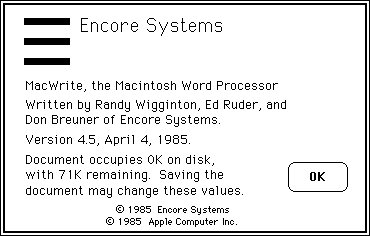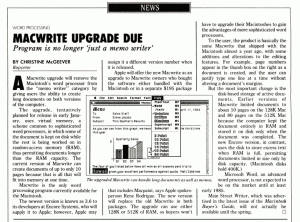Disk-Based MacWrite
158 words
2K on disk
April 1985
 Disk-Based MacWrite
Disk-Based MacWrite
Finally, more than 10 pages
What was “Disk-Based” MacWrite, and how did it differ from previous versions?
Some people assume that the “Disk” in question refers to where the program is stored — that this version is somehow different from a previous version stored in ROM. But the term actually refers to where documents were saved.
There were two Macintosh Technical Notes issued by Apple on MacWrite — one for the Memory-Based version, and one for the later Disk-Based.
As early as December 1984, rumors were flying about a revision that would remove the limitations of the memory-based approach.
A March 1985 article notes that “Apple has been “pre-releasing” disk-based versions of MacWrite which create files incompatible with the old memory-based MacWrite.”
Next, we should mention that this version was authored by a company named Encore Systems:

Encore was the company which originally authored MacWrite. A May 1985 article from InfoWorld seems to suggest that 4.5 was a substantial rewrite with new features.




